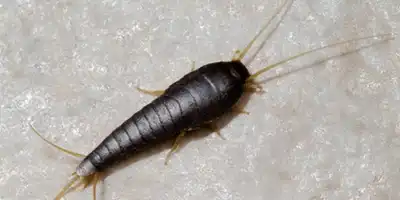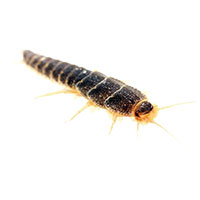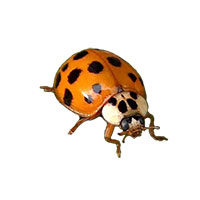Fast Facts![]()
| Color | Deriving its name from the color of its body, the silverfish typically appear shiny silver or pearl gray. |
| Size | The common silverfish is about 1/2 – 3/4″ in length. |
| Appearance | They are slender, flat and “carrot-shaped”, its body gradually tapering from the front to the rear. A trio of long, thin, tail-like appendages extends from the rear. The insect also has two long antennae which when combined with the tail appendages, nearly equal the length of the body. Nocturnal by nature, silverfish are fast-moving but do not possess wings for flight. |
Silverfish Diet
Silverfish can go for long periods of time without nourishment. When the pests eat, they prefer foods high in carbohydrates and protein, including cereal grains, dried meat, dead insects, and other silverfish. Inside homes, silverfish may attack and eat synthetic fabrics, silk, glue contained in book bindings, wallpaper, and paper products. Nymphs can cause just as much damage to books, paper products, stored foods, and clothing as adults since they need to feed in order to grow.
Silverfish Habitat
Silverfish are typically seen in moist, humid areas in the home, such as bathrooms, basements, and attics, much like its relative the firebrat. They tend to hide their presence from humans, which means any damage they cause could go unnoticed.
Silverfish Life Cycle
Eggs
Silverfish lay their eggs in cool, moist, and dark places, such as cracks, crevices, and other narrow spaces near sources of food. The tiny, white, oval-shaped eggs are laid in groups of 1 to 200.
Nymph
Newly hatched silverfish are white and squishy. They do not grow their characteristic silver scales for several weeks. Once the scales come in, young nymphs have the appearance of tiny adult silverfish. The insects continue to molt throughout their lives, maturing through over 60 instars and growing to an average size of 3/4″.

Adult
When temperatures are favorable, silverfish grow from eggs to sexually mature adults in the span of a couple of months. However, in colder climates, the process can take as long as two years. Silverfish are one of the few insect species that continue to molt even after reaching maturity. Adults congregate in musty areas to mate, and female silverfish are capable of producing thousands of offspring over the course of their lives. Adults live up to three years in ideal conditions.
Silverfish Damage
Primarily just a nuisance, silverfish are not known to transmit any diseases or cause structural damage to homes. For the most part, homeowners, museum workers, and librarians detest the creature because of its appetite for books and paper. Damages can be costly, especially if rare or antique pieces are fed on.
Signs of a Silverfish Infestation
Outside of seeing the insects scurrying from place to place indoors, the most common sign of a silverfish infestation is the damage they inflict upon book bindings, wallpaper, and fabrics found around the home.
Hiding Spots
Look for silverfish in basements, storage areas, closets, and crawl spaces.
Holes
May notice holes at irregular intervals in books or wallpaper, sometimes accompanied by yellow staining.
Feces
Remain alert for the tiny fecal matter that looks like specks of pepper.
Moisture
Silverfish are often found in areas of high moisture, including bathtubs and sinks.
Silverfish Prevention & Control
Silverfish Prevention
As silverfish prefer dark and moist hiding places, eliminating their favorite environmental conditions can help prevent the insects from infesting.
- Reroute drainage away from the home to reduce damp conditions in basements or crawl spaces.
- Keep interior floors clear of debris and use a dehumidifier to lower the relative humidity within the structure.
- Keep all dry goods in properly sealed containers, and store books in a moisture-free environment.
Silverfish Control
Your Batzner Service Specialist will come to your property to identify the source of the silverfish and determine the proper treatment method. Determining the best course of action can be a challenge for a silverfish infestation. Many times a bait will be placed on top of the insulation in the attic, in any accessible wall void areas, the basement and behind all switch and other plates.
Silverfish can be difficult to eliminate with sticky traps and other store-bought baits. While infestations may not reach large enough numbers to draw notice, the insects are resilient and sometimes return even after they are believed to be eliminated.
For silverfish infestations, count on a professional pest management service to take care of the problem knowledgeably and successfully.
Need help with Silverfish?
We'll call you! Leave your information below.





